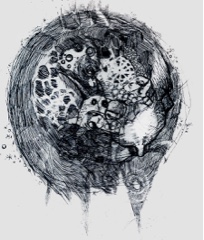It's hard to believe that today was our last in Ireland. It rushed by like the speed limits on the roads. More than anything else we wanted to see the Book of Kells that luckily a friend said was a "must see" since we'd never heard of it. Good thing I bought fast track tickets online a month ago because even now the lineups are impressive. More about the Book of Kells later.
Things that caught our eye around the city --
Fun name and eye catching door.
A whole store of knockers. Who uses knockers anymore?
And a very nice door with black knocker.
Guy on left in vogue.
Must have been hot in those getups.
You could put 15 country roads side by side in some Dublin streets. This one is wider than Toronto's University Avenue.
I'm struggling to read Joyce's Ulysses for the third time. So we visited the James Joyce Centre.
The Hoards of Ireland on display at the National Museum
Between the Neolithic period through the Iron And Bronze Ages the Roman and Medieval Eras, people hoarded their valuables in the bogs. They buried stunningly beautiful gold ornaments, copper items, coinage and tools into the bog, sometimes for personal safe keeping, sometimes to hide, occasionally as offerings to Gods. They often intended to retrieve the items and had perhaps forgotten the location or had to flee the area. Perhaps they'd gotten killed. Those were brutal, brutal times.
This fellow is wearing in his ear the gold Bronze age (2500 BCE to 500 BCE) object that you see below. The object contains gold nuggets.
A gold neckpiece.
Bog Bodies
I love learning about ancient peoples but not necessarily their violent deaths. The bog people, on display at the National Museum are fascinating because they are so old, dating back to 8000 BC and so well mummified in peat bog.
Bog bodies are exciting for scientists because they retain their skin and organs. So with careful measurements and MRIs, quite accurate models are made from the specimen. The head below was created based on the body below it.
The head modelled from the bog body below. These people are white. Chemicals in peat tans the skin.
The fellow is 2500 years old, from the Iron age and was probably killed by an axe during a ritual sacrifice. I wonder how you would feel if you were about to be scrificed. Maybe to be chosen would have been an honour.
The Book of Kells
The Book of Kells, on display at Trinity College, is an illuminated manuscript of Matthew, Mark, Luke and John. It was created by monks in a monastery in Ireland around 800 CE. The beautiful text and illustrations are written with feather pens and a variety of inks made from natural dyes from around the world at the time combined with substances like arsenic on vellum made from calf skin.
It's a miracle that the Books have survived because they escaped Viking and other plunderings, raids, fires and wars. At one point the four books were buried in the ground. The manuscript takes its name from the Abbey of Kells where it lived for centuries.
Pages from the Book of Kells.
We'll remember the friendly Irish people, their smiles and laughter despite hardship. I'll always have the beautiful green countryside in my mind's eye. Bob will never forget the roads.
From the window of our Doolen B and B.
This road was for two cars, but you had to edge off the road to pass. On the left side of the road you can see a road narrowing sign that makes you think they've got to be kidding.
Bob and I send you best wishes and thoughrs until our next adventure. Be well, Lynda

































































